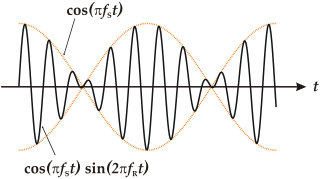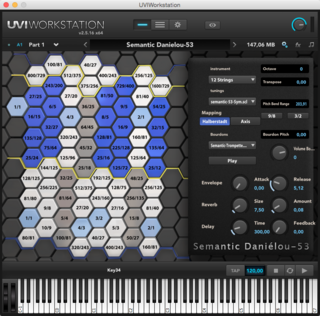Related Research Articles

An equal temperament is a musical temperament or tuning system, which approximates just intervals by dividing an octave into equal steps. This means the ratio of the frequencies of any adjacent pair of notes is the same, which gives an equal perceived step size as pitch is perceived roughly as the logarithm of frequency.

In music, just intonation or pure intonation is the tuning of musical intervals as whole number ratios of frequencies. Any interval tuned in this way is called a just interval. Just intervals consist of members of a single harmonic series of a (lower) implied fundamental. For example, in the diagram, the notes G and middle C are both members of the harmonic series of the lowest C and their frequencies will be 3 and 4 times, respectively, the fundamental frequency; thus, their interval ratio will be 4:3. If the frequency of the fundamental is 50 Hertz, the frequencies of the two notes in question would be 150 and 200.

A musical keyboard is the set of adjacent depressible levers or keys on a musical instrument. Keyboards typically contain keys for playing the twelve notes of the Western musical scale, with a combination of larger, longer keys and smaller, shorter keys that repeats at the interval of an octave. Depressing a key on the keyboard makes the instrument produce sounds—either by mechanically striking a string or tine, plucking a string (harpsichord), causing air to flow through a pipe organ, striking a bell (carillon), or, on electric and electronic keyboards, completing a circuit. Since the most commonly encountered keyboard instrument is the piano, the keyboard layout is often referred to as the piano keyboard.

In music, there are two common meanings for tuning:

The piano is an acoustic, stringed musical instrument invented in Italy by Bartolomeo Cristofori around the year 1700, in which the strings are struck by wooden hammers that are coated with a softer material. It is played using a keyboard, which is a row of keys that the performer presses down or strikes with the fingers and thumbs of both hands to cause the hammers to strike the strings.

Microtonal music or microtonality is the use in music of microtones—intervals smaller than a semitone, also called "microintervals". It may also be extended to include any music using intervals not found in the customary Western tuning of twelve equal intervals per octave. In other words, a microtone may be thought of as a note that falls between the keys of a piano tuned in equal temperament.
Benjamin Burwell Johnston Jr. was an American contemporary music composer using just intonation. He was called "one of the foremost composers of microtonal music" by Philip Bush (1997) and "one of the best non-famous composers this country has to offer" by John Rockwell (1990).

Xenharmonic music is that which uses a tuning system which neither conforms to nor closely approximates the common 12-tone equal temperament. The term xenharmonic was coined by Ivor Darreg, from xenia, "hospitable," and xenos "foreign." He stated it as being "intended to include just intonation and such temperaments as the 5-, 7-, and 11-tone, along with the higher-numbered really-microtonal systems as far as one wishes to go."

A monochord, also known as sonometer, is an ancient musical and scientific laboratory instrument, involving one (mono-) string (chord). The term monochord is sometimes used as the class-name for any musical stringed instrument having only one string and a stick shaped body, also known as musical bows. According to the Hornbostel–Sachs system, string bows are bar zithers (311.1) while monochords are traditionally board zithers (314). The "harmonical canon", or monochord is, at its least, "merely a string having a board under it of exactly the same length, upon which may be delineated the points at which the string must be stopped to give certain notes," allowing comparison.

A quarter tone is a pitch halfway between the usual notes of a chromatic scale or an interval about half as wide as a semitone, which itself is half a whole tone. Quarter tones divide the octave by 50 cents each, and have 24 different pitches.

Piano tuning is the act of adjusting the tension of the strings of an acoustic piano so that the musical intervals between strings are in tune. The meaning of the term 'in tune', in the context of piano tuning, is not simply a particular fixed set of pitches. Fine piano tuning requires an assessment of the vibration interaction among notes, which is different for every piano, thus in practice requiring slightly different pitches from any theoretical standard. Pianos are usually tuned to a modified version of the system called equal temperament.

The piano requires various forms of maintenance to produce its best sound. Maintenance is also important for the appearance of the piano.

In acoustics, a beat is an interference pattern between two sounds of slightly different frequencies, perceived as a periodic variation in volume whose rate is the difference of the two frequencies.

In music, 19 equal temperament, called 19 TET, 19 EDO, or 19 ET, is the tempered scale derived by dividing the octave into 19 equal steps. Each step represents a frequency ratio of 19√2, or 63.16 cents.
In music, intonation is the pitch accuracy of a musician or musical instrument. Intonation may be flat, sharp, or both, successively or simultaneously.
Geoff Smith is a musical performer and composer from Brighton, England. He was previously a member of the group Attacco Decente. He was a pupil at Varndean College from 1974.

In music, an electronic tuner is a device that detects and displays the pitch of musical notes played on a musical instrument. "Pitch" is the highness or lowness of a musical note, which is typically measured in Hertz. Simple tuners indicate—typically with an analog needle-dial, LEDs, or an LCD screen—whether a pitch is lower, higher, or equal to the desired pitch. Since the early 2010s, software applications can turn a smartphone, tablet, or personal computer into a tuner. More complex and expensive tuners indicate pitch more precisely. Tuners vary in size from units that fit in a pocket to 19" rack-mount units. Instrument technicians and piano tuners typically use more expensive, accurate tuners.

In musical tuning, a temperament is a tuning system that slightly compromises the pure intervals of just intonation to meet other requirements. Most modern Western musical instruments are tuned in the equal temperament system. Tempering is the process of altering the size of an interval by making it narrower or wider than pure. "Any plan that describes the adjustments to the sizes of some or all of the twelve fifth intervals in the circle of fifths so that they accommodate pure octaves and produce certain sizes of major thirds is called a temperament." Temperament is especially important for keyboard instruments, which typically allow a player to play only the pitches assigned to the various keys, and lack any way to alter pitch of a note in performance. Historically, the use of just intonation, Pythagorean tuning and meantone temperament meant that such instruments could sound "in tune" in one key, or some keys, but would then have more dissonance in other keys.
A[n anomalous chord is,] A chord containing an interval which has been made very sharp or flat in tempering the scale for instruments of fixed pitches.

Sonido 13 is a theory of microtonal music created by the Mexican composer Julián Carrillo around 1900 and described by Nicolas Slonimsky as "the field of sounds smaller than the twelve semitones of the tempered scale." Carrillo developed this theory in 1895 while he was experimenting with his violin. Though he became internationally recognized for his system of notation, it was never widely applied. His first composition in demonstration of his theories was Preludio a Colón (1922).

The Semantic System is based on a microtonal musical scale tuned in just intonation, developed by Alain Daniélou.
References
- ↑ Mills, Merope (1 Feb 2003). [ttp://arts.guardian.co.uk/news/story/0,,886739,00.html "Composer reinvents the piano"]. The Guardian.